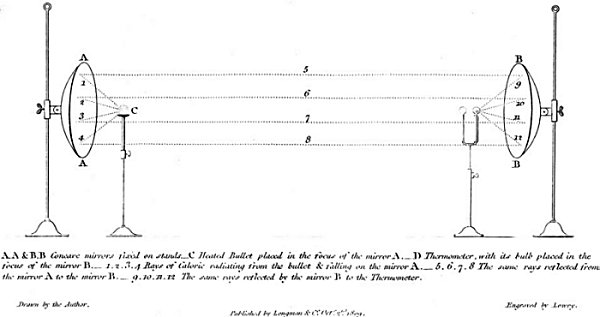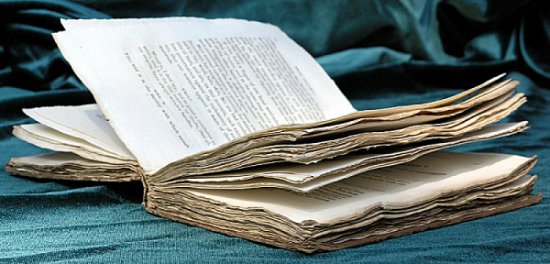 et us begin with one book in particular, one that many people owned. As we open our copy, and begin reading, we find ourselves in a British parlor. The year is 1806, and a tutor, whom we call Mrs. B, talks with two young girls, Caroline and Emily. The subject is heat radiation. But, in the language of the times, Mrs. B calls it free caloric. She says to the girls:
et us begin with one book in particular, one that many people owned. As we open our copy, and begin reading, we find ourselves in a British parlor. The year is 1806, and a tutor, whom we call Mrs. B, talks with two young girls, Caroline and Emily. The subject is heat radiation. But, in the language of the times, Mrs. B calls it free caloric. She says to the girls:
I should not quit the subject of free caloric without observing to you that different [surfaces] possess the power of radiating in very different degrees.
Some ... curious experiments have been made ... on this subject, and [with the assistance of a] thermometer [we see] that black surfaces radiate most ... and polished surfaces least of all.
Emily pipes up, "Do we suppose these surfaces are all at the same temperature?" Mrs. B answers, "Undoubtedly. I will show you an ingenious apparatus. This cubical tin canister has four sides – one simply blackened, the next roughened, the next painted white, and the fourth polished."
[These quotations have been paraphrased slightly.]
She fills the tin with hot water, then she uses a focusing mirror to reflect heat radiating from each side onto a thermometer. As she moves around the tin, each reading is lower.

The mirror reflection system with which the radiation of caloric could be magnified and measured. In the experiment that Marcet describes, the heated bullet, C, would be replaced with the side of the water-filled tin, and mirror A-A would be eliminated.
Caroline is more inclined to play the bored, you-can't-fool-me role. She says, "The water within the vessel gradually cools, and the thermometer in consequence gradually falls."
True, Mrs. B allows, but then she turns back to the blackened surface. The thermometer goes back up to a higher reading. In the end, the girls are convinced that the shiny surface is the worst radiator, and the blackened one is best.
Emily, the more incisive and willing of the two, jumps in again: "According to these experiments, light-coloured dresses, in cold weather, should keep us warmer than black clothes, since the [black radiates] so much more than [white.]" That, too, might be true, Mrs. B allows, if one were standing still, and in the shade.
But: Another property of black surfaces is that they absorb more of the caloric in sunshine that reaches them. Therefore, it's best to wear black in cold weather.
So the plot thickens: Caroline and Emily begin posing thought models and questioning each other. They gradually expose issues about thermal equilibrium and energy conservation. Their conversation is not only very sophisticated for the early 19th century; it's also prescient. It catches all the themes that would soon surround the evolution of modern thermodynamics.
We read all this in this book titled Conversations on Chemistry. The author is Jane Haldimand Marcet. Although early editions of the book don't include her name, or give away her gender, she nevertheless begins her Preface with this remarkable paragraph:
In venturing to offer to the public, and more particularly to the female sex, an Introduction to Chemistry, the author, herself a woman, conceives that some explanation may be required; and she feels it the more necessary to apologize for the present undertaking, as ... she can have no real claims to the title of chemist.
Well, Marcet had nothing to apologize for. And this book was only the first in her long series of such texts. The characters, Emily, Caroline, and Mrs. B are fictitious, but they've become quite real to me. Like Harry Potter or Nancy Drew, they appear in book after book. Marcet brings them back to life in Conversations on Natural Philosophy, Conversations on Political Economics, Conversations on Vegetable Physiology and more. And, we are about to find that a remarkable cross-section of England and America read, and were changed by, books such as these.

J. H. Marcet, Conversations on Chemistry; in which the Elements of that Science are Familiarly Explained and Illustrated by Experiments. In two Volumes. 4th ed. Vol. I. On Simple Bodies (London: Longman, Hurst, Rees, Orme, and Brown, 1813): see pp. 61-66.
For a later edition of Marcet's chemistry, see: T. P. Jones, New Conversations on Chemistry adapted to the present state of that science wherein in its elements are clearly and ... (Philadelphia: John Grigg, 1833). Jones was an American educator who edited Marcet's book and added questions for classroom use. He made no secret of Marcet's identity in his Preface, although he does not include her name on the title page.)